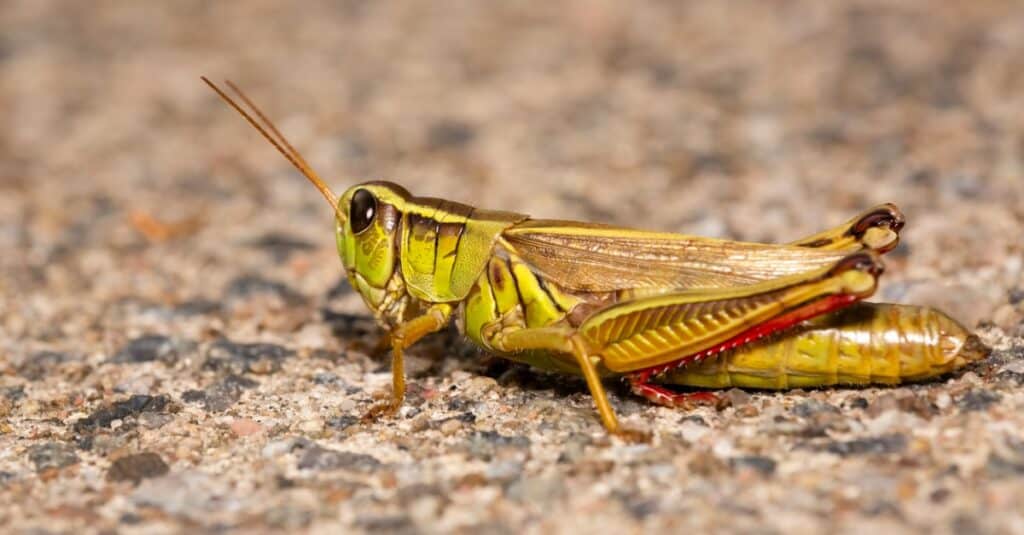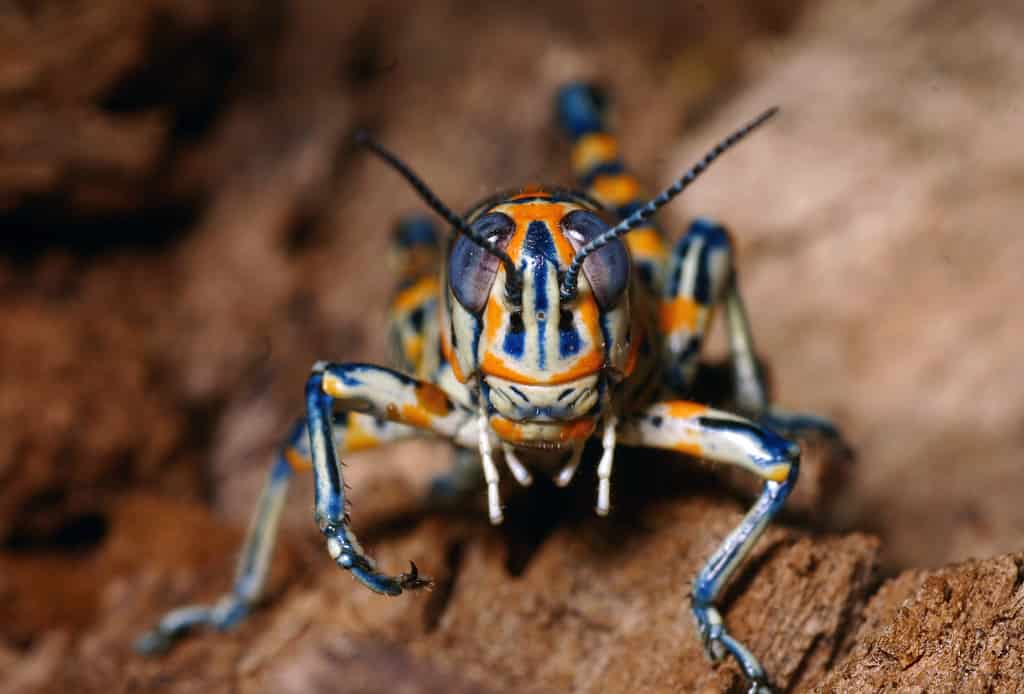Grasshoppers are well-known leaping insects that have existed for approximately 250 million years. These chewing, plant-eating creatures have large hind legs capable of prodigious jumps to escape danger. Their green color, sometimes combined with reds, yellows, or browns, allows them to camouflage themselves, though they may also jump and flash their wings to startle or confuse a predator before flying for a short distance to get away. Sometimes, certain species gather in swarms, developing flight capabilities and becoming locusts, destroying crops. Here, though, we are just speaking of the lowly grasshopper. In addition to being part of the ecological balance, grasshoppers also hold a place of importance as symbols in cultures worldwide.

Read on for five meanings and signs of seeing a grasshopper.
Meanings and Signs of Seeing a Grasshopper

What might the spiritual implications be of seeing a grasshopper?
©juerginho/Shutterstock.com
- Freedom and independence: With those long legs, the grasshopper can move with abandon. This can symbolize the importance of freedom.
- Spiritual enlightenment: Some people think that since grasshoppers can see things from an elevated and unusual perspective, given their leaping ability, this symbolizes enlightenment and an ability to perceive new realities.
- Inability to settle down or commit: The seeming nature of the grasshopper to always be in motion and to move in giant leaps represents an ability to come to a resting point or final decision.
- Luck: Similarly, the ability to leap away and over obstacles can represent the ability to reach one’s goals, achieving financial and personal success.
- Wisdom: Finally, some cultures see grasshoppers as symbols of wisdom and nobility.

Grasshoppers have spiritual significance in many cultures.
©iStock.com/Luc Pouliot
Grasshoppers Across Cultures
Given the longevity of the grasshopper as a family of insects, it is no surprise that they figure prominently in art and literature, in addition to their meanings and signs in religion and folklore. The grasshopper was featured in one of Aesop’s most well-known fables to represent laziness and foolishness. In his short story “Poprygunya,” Anton Chekhov referred to a faithless woman as a grasshopper because she was constantly hopping from one man to another. The 1970 film, “The Grasshopper,” directed by Jerry Pariry, loosely follows Chekhov’s story.
Historically, the grasshopper was the symbol of Athens during ancient Greece. It was among the most common of insects on the Attican plains. Athenians would sometimes wear a golden grasshopper brooch to signal their purity of Athenian ancestry. At one point, the figure of a grasshopper hung before the Acropolis as a form of protective magic.
An apocryphal tale tells that the great London financier, Sir Thomas Gresham’s ancestor, Robert de Gresham, was abandoned as an infant. He was found when the chirping of a grasshopper led a woman to him. The family later became wealthy and added the grasshopper to their coat of arms.
Gresham also made the grasshopper his emblem and included it in many of the concerns he became a part of, such as the golden grasshopper at the top of the Royal Exchange and one incorporated into a sign above a building that used to house one of his goldsmiths.
More practically speaking, when some grasshopper species swarm and develop as locusts, they can cause great destruction and famine. Even in small numbers, they can impact crops as pests. Some countries, like Mexico and Indonesia, return the favor by making a meal of them.

Many cultures have meanings and signs associated with seeing a grasshopper.
©Michael Benard/Shutterstock.com
Meaning and Symbolism Behind Aesop’s Fable of the Ant and the Grasshopper
The storyteller, Aesop, who lived in ancient Greece around the 6th century BCE, included the grasshopper in his tale of the Ant and the Grasshopper. The story has many variations, but the general concept is this: during the summer, the ant works and puts food away for the future while the grasshopper sings and dances. When winter arrives, the grasshopper comes to the ant begging for food, but the ant tells the grasshopper no.
The theory is that the story teaches a moral lesson about work, responsibility, and preparation for the future. The grasshopper symbolizes those who play and don’t plan or work for tomorrow. The ant represents the worker who plans for the future and works hard during times of plenty.
Conclusion
The grasshopper has a prominent place in stories and cultures around the world. In addition to its place in art and literature, the grasshopper is seen in many cultures as having signs and meanings related to luck, wisdom, nobility, enlightenment, freedom, and indecision. There are also associations with change, both good and bad, attached to the grasshopper in many cultures.
Summary of 5 Meanings and Signs of Seeing a Grasshopper
| Number | Meanings & Signs |
|---|---|
| 1 | Freedom and Independence |
| 2 | Spiritual Enlightenment |
| 3 | Inability to Settle Down or Commit |
| 4 | Luck |
| 5 | Wisdom |
The photo featured at the top of this post is © happymay/Shutterstock.com
Thank you for reading! Have some feedback for us? Contact the AZ Animals editorial team.






